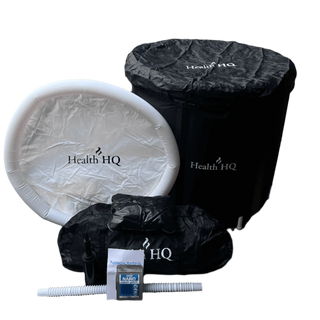Unlocking the Wellness Potential of Sauna Bathing: A Comprehensive Guide
By HealthHQ
Introduction
Sauna bathing, a practice rooted in ancient traditions and observed across diverse cultures, has surged in popularity due to its promising health benefits. Research, including the renowned Kuopio Ischemic Heart Disease Risk Factor (KIHD) Study, has shed light on the remarkable advantages of sauna use. In this comprehensive guide, we explore the myriad facets of sauna bathing and its impact on health and wellness. We would like to also take a moment to share our gratitude for public figures such as Dr Ronda Patrick, Dr Andrew D. Huberman and so many more for helping to surface alot of the incredible research in the heat and cold therapy space.
The Sauna Experience
Sauna bathing involves brief exposure to intense heat, typically characterized by sessions of 5-20 minutes at temperatures exceeding 78.9°C (174°F). The sauna landscape offers variety, from traditional saunas with electric heaters to infrared saunas that use radiant heat. Moreover, saunas can be dry (low humidity) or wet (high humidity), each offering a unique sensory experience.
Health Benefits of Sauna Use
Cardiovascular Health: The cardiovascular benefits of sauna bathing are striking. Regular use, especially at a frequency of 4-7 times per week, is linked to a 50 percent reduction in cardiovascular-related mortality. Additionally, sauna enthusiasts enjoy a 40 percent lower risk of premature death from any cause, not just cardiovascular issues. The sauna's influence extends to brain health, reducing the risk of dementia and Alzheimer's disease by 66 percent and 65 percent, respectively. Mental health also reaps rewards, with sauna users having a 77 percent lower likelihood of developing psychotic disorders, irrespective of other lifestyle factors.
Molecular Mechanisms: A deep dive into the molecular realm reveals how sauna use protects and enhances health. Heat Shock Proteins (HSPs) shield cells from damage due to stressors, while Nrf2 regulates genes with cytoprotective, antioxidant, and anti-inflammatory functions. FOXO3 proteins play a pivotal role in human lifespan and aging, and the sauna's influence on these factors holds promise for longevity. The balance between pro-inflammatory cytokine IL-6 and anti-inflammatory cytokine IL-10, both influenced by sauna exposure, plays a vital role in managing inflammation.
Cardiovascular Disease Prevention: Sauna use mirrors some effects of exercise, leading to increased heart rate and blood pressure during sessions, followed by reduced levels post-sauna. Over the long term, it improves blood pressure, endothelial function, and reduces inflammation. Additionally, frequent sauna use significantly lowers the risk of cardiovascular-related mortality and sudden cardiac death.
Clinical Applications: Sauna therapy's applications extend to clinical settings. Waon therapy, a specialized sauna treatment, has demonstrated improvements in endurance, heart size, and disease status among patients with advanced congestive heart failure. Patients with ischemic heart disease experience enhanced vascular endothelial function, while those with peripheral artery disease report improved pain levels, walking endurance, and blood flow.
Metabolic Health: Sauna therapy may modulate blood lipid levels, reducing total cholesterol and LDL cholesterol in healthy adults. Moreover, it stimulates the release of growth hormone and helps regulate insulin and glucose levels, potentially benefiting individuals with insulin resistance and diabetes.
Cognitive and Mental Well-being: Sauna use enhances neurogenesis by increasing the production of brain-derived neurotrophic factor (BDNF), improving learning, memory, and mood. Additionally, it reduces the risk of Alzheimer's disease and exhibits potential as an adjunctive treatment for depression.
Physical Fitness and Athletic Performance: Athletes and fitness enthusiasts can harness the sauna's benefits. Sauna use increases endurance, improves thermoregulation during exercise, and enhances cardiovascular adaptations. Heat acclimation from sauna use can reduce glycogen use during endurance exercise and boost overall endurance.
Muscle Maintenance and Detoxification: Sauna bathing contributes to muscle maintenance by reducing muscle protein degradation during disuse or immobilization. The process promotes positive net protein synthesis, a key factor in preventing muscle atrophy and aiding recovery. Additionally, sweating during sauna use facilitates the excretion of toxicants, including heavy metals (e.g., aluminum, cadmium, lead, cobalt), bisphenol A (BPA), polychlorinated biphenyls (PCBs), and phthalates.
Best Practices and Considerations: While sauna bathing offers numerous health benefits, it should be approached with caution by certain populations, such as pregnant women and children, who should seek medical advice before use. Maintaining proper hydration and electrolyte balance is essential to prevent dehydration and electrolyte deficits.
Conclusion
In conclusion, sauna bathing is a multifaceted health and wellness practice with ancient roots and modern scientific backing. Its potential to enhance cardiovascular health, mental well-being, and physical fitness is supported by extensive research, including the KIHD Study. Moreover, the sauna's impact on molecular mechanisms, metabolic health, and muscle maintenance underscores its holistic benefits. Sauna use is generally considered safe for healthy adults and may be therapeutic for various health conditions. However, individuals in special populations should exercise caution, seeking medical guidance when necessary.
Unlock the potential of sauna bathing for a healthier, more vibrant you. Experience the benefits backed by science and centuries of tradition. Visit HealthHQ to embark on your sauna journey today!








